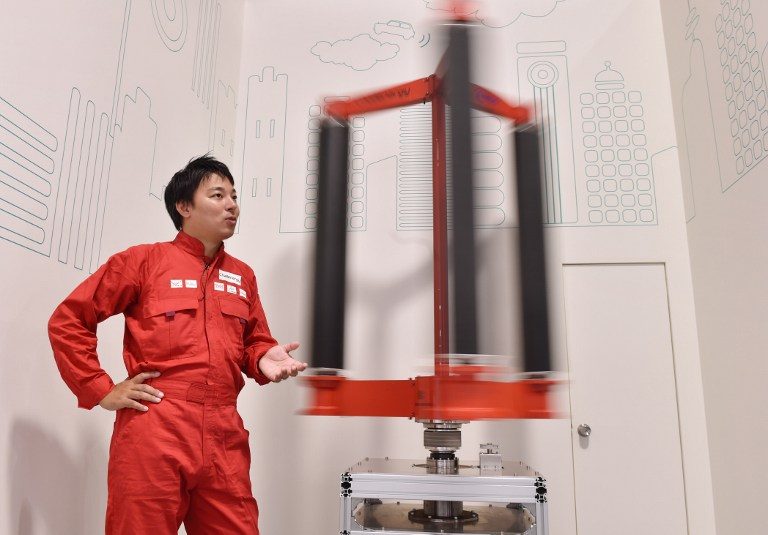SUMMARY
This is AI generated summarization, which may have errors. For context, always refer to the full article.

TOKYO, Japan – Most people look for a place to hide when a typhoon is on the horizon, but Atsushi Shimizu hopes that the fury of nature may one day help resource-poor Japan tackle its energy woes.
As thousands of Australians seek shelter from a “monster” cyclone battering the country’s northern coast, the Tokyo-based engineer believes that his bladeless wind turbine can not only stand up to the raw force of these destructive storms, but also harness that power to generate electricity.
Shimizu’s egg-beater shaped creation – it has 3 cylinders and a central rod – responds to wind coming from any direction and doesn’t use a propeller to spin.
Instead it takes advantage of the Magnus effect, a force that sees air curve when passing by a spinning object, such as a football.
“There are some estimates that wind power has more potential here than solar,” said the 37-year-old, who quit his job at an engineering firm to launch startup Challenergy in 2014.
“But we haven’t been able to turn that much of this wind power into actual energy here in Japan.”
Japan turned to expensive and polluting fossil-fuel options when it shut down dozens of nuclear reactors in the wake of the 2011 Fukushima accident.
A quake-sparked tsunami swamped the plant in Fukushima, sparking the worst atomic disaster since Chernobyl in 1986.
Six years later, a wary public is resisting government efforts to switch reactors back on – boosting interest in solar, wind and other renewable energy sources.
The amount of electricity produced by wind nearly doubled in 2016 from a year earlier, according to a recent survey by the Japan Wind Power Association.
Still, the increase – 300 megawatts – can only power tens of thousands of homes in a nation of 127 million.
And wind power’s share of Japan’s total energy mix is still less than one percent.
Shimizu and others are determined to change that.
“After the Fukushima accident, I had to question myself as a Japanese person if it would be justified to continue operating nuclear plants in this country,” Shimizu said.
‘Interesting challenge’
Japan’s wind patterns and hilly terrain are not conducive to using the three-blade wind turbines common in other countries. Furthermore, the threat of typhoons can turn these turbines into matchsticks, unlike Shimizu’s more durable creation.
Last summer, Shimizu and his staff tested a prototype of their turbine with a tiny one kilowatt capacity in southern Okinawa – it survived winds that would usually shut down a three-blade turbine.
But some remain skeptical of the wind turbine’s chances.
Mecaro, another firm in northern Japan, has struggled to commercialize its windmill-shaped wind turbines, which also rely on the Magnus effect, said Izumi Ushiyama, a wind energy expert at Japan’s Ashikaga Institute of Technology.
“A wind turbine like Challenergy’s could be very durable in strong winds, but without operating it throughout the year we don’t know if it could produce more power than conventional turbines,” he said.
“This is a very interesting challenge. It’s literally a ‘Challenergy’,” Ushiyama added, referring to the company’s name.
The little firm hopes to start mass producing a turbine with about 10 times the capacity by 2020, when Tokyo hosts the Olympics.
It’s a far cry from the one million kilowatts of energy that just one of Japan’s nuclear reactors could produce.
Still, Shimizu has high hopes for his turbine both at home and in other nations which get hammered by wind-packed storms.
“If we can invent a wind turbine that suits Japan’s environment, we’ll be able to build them in many other places around the world that have a similar climate,” Shimizu said.
“That’s our dream.” – Rappler.com
Add a comment
How does this make you feel?
There are no comments yet. Add your comment to start the conversation.